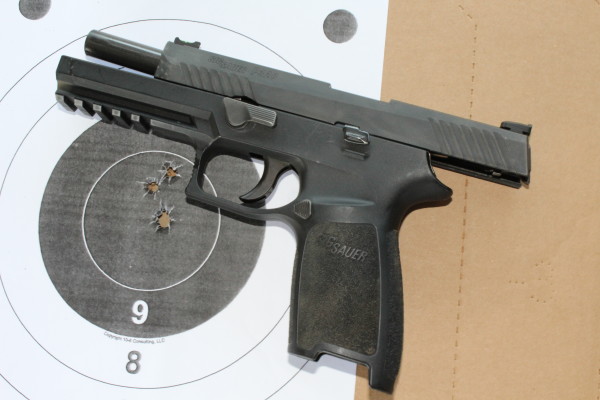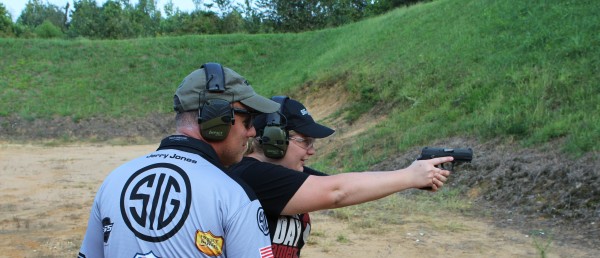 “You need a maximum strength prescription of ‘slow…down’. Speed comes later,” he said in that western Kentucky accent that almost forces a sense of calm. It was obvious this would be a different kind of class. Operation Specific Training offers a process-oriented curriculum as opposed to a goal-oriented curriculum. I would come to know what that meant over the next two days.
“You need a maximum strength prescription of ‘slow…down’. Speed comes later,” he said in that western Kentucky accent that almost forces a sense of calm. It was obvious this would be a different kind of class. Operation Specific Training offers a process-oriented curriculum as opposed to a goal-oriented curriculum. I would come to know what that meant over the next two days.
I had Internet-known Jerry Jones, the President of Operation Specific Training, for several years at that point. (Editor’s Note: We are proud to have Jerry here as a regular contributor here at Modern Service Weapons.) We had corresponded regularly on a forum and via email, but had never met in person. I’d always found him to be exceptionally knowledgeable and truly interested in the education of others. He’s notorious for going to great lengths to answer questions and provide assistance to perfect strangers online. During an email exchange, I told Jerry I was having trouble with some fundamentals after surgery. I don’t know if Jerry felt sorry for me or was just tired of reading my polysyllabic swearing, but he invited me to his Practical Fundamentals class in Paducah, KY. It seemed like a perfect opportunity to regain some skill and maybe a little swagger.
Jones has an impressive list of qualifications and accomplishments. He spent five years in the Marine Corps right out of high school and it shows in his work ethic and self-discipline. He shoots competitively for Team Sig, is an experienced sniper, SWAT team trainer, POST-certified firearms instructor and writer credited with dozens of online and print articles. Jones gives a lot of credit for his success as a firearms instructor to two of his mentors, Ernest Langdon and Bruce Gray. Gray is the author of the Practical Fundamentals program.
 The OpSpec Difference
The OpSpec Difference
Although they offer several training options, Practical Fundamentals is OpSpec’s flagship course. OpSpec teaches this course four times a year at Sig Sauer Academy, which is among the premier training facilities in the world. The class is so popular it generally fills within days of being posted. Many of those enrollees are repeat students seeking to concrete their skills. The calm approach and positive nature of the Practical Fundamentals curriculum is reflective of Jerry’s personality and teaching style. Jones analogized Practical Fundamentals as, “a road map to durable, consistent skills.” Phrases like that tend to help a student grasp the principle the instructor is trying to teach them. For example, instead of the familiar, “aim small, miss small,” we heard, “aim small, hit small.”
Classroom
The Practical Fundamentals curriculum was exhaustively researched and carefully constructed to the finest point. We spent most of the first morning in the classroom. Of course, firearms safety and range rules were the first instructional focus. The rest of the morning was devoted to the seven fundamentals of marksmanship. If they weren’t ingrained beforehand, they will be after two days of training:
- Grip
- Stance
- Sight alignment
- Sight picture
- Breathing
- Follow-through
- Trigger control
There isn’t space here to delve too deeply, but number five (breathing) is a great example. Insufficient breathing degrades our ability to shoot well, as oxygen is being withheld from the body. The hands begin to shake and visual focus diminishes. Visual field anomalies, such as the commonly called, “eye-floaters” obscure the shooter’s vision. Regular, measured breaths can help to allay all these issues.
 The most important of “The Big Seven” is, undoubtedly, trigger control. No matter what OpSpec class you attend, you will see a strong focus on the proper manipulation of the trigger. It is rightfully considered the most important of the fundamentals by most pistol instructors. Note the above picture of two groups I fired in the class. Compare them to the group in the middle when I was just holding the gun on target while Jerry manipulated the trigger for me during a “buddy drill.” Jones diagnosed that I was both jerking the trigger and “thumbing” the pistol which caused my shots to hit low and right. I didn’t realize I was doing it, but the proof is on the paper. As I worked through those issues, my groups became tighter and more centered. Jerry once told me, ” the guys who are better than us can manipulate the fundamentals under stress at speed.”
The most important of “The Big Seven” is, undoubtedly, trigger control. No matter what OpSpec class you attend, you will see a strong focus on the proper manipulation of the trigger. It is rightfully considered the most important of the fundamentals by most pistol instructors. Note the above picture of two groups I fired in the class. Compare them to the group in the middle when I was just holding the gun on target while Jerry manipulated the trigger for me during a “buddy drill.” Jones diagnosed that I was both jerking the trigger and “thumbing” the pistol which caused my shots to hit low and right. I didn’t realize I was doing it, but the proof is on the paper. As I worked through those issues, my groups became tighter and more centered. Jerry once told me, ” the guys who are better than us can manipulate the fundamentals under stress at speed.”
Live Fire Lessons
We did everything from Bump Drills to Bill Drills to Box Drills. No matter the course of fire, the goal was the same: technical marksmanship. As mentioned above, students are encouraged to go slow from dry practice in the classroom to the last shot fired on the range in this class. In fact, rapid draw stokes, press-outs or trigger manipulations were strongly discouraged. We never even saw a shot timer. The focus was always on building a solid technique with slow, deliberate repetition. Still, this is not a beginner’s class. A prospective student must have decent gun handling skills and a solid grasp of how their equipment works. If in doubt, OpSpec offers another course, Introduction to Practical Fundamentals, as a sort-of optional prerequisite. This one-day class is designed to aid the shooter who may have a little less training under their belt ensure they will get the most from their two day Practical Fundamentals experience.
While discussing prerequisites, Jerry told me that his dream had always been to teach the, “Mother of All Classes.” If you check the OpSpec website, you’ll find a course called “MOAC.” OpSpec is teaching a MOAC class at Sig Academy at this writing. Practical Fundamentals or a similar trigger control-based class is prerequisite to this 40-hour course in which a student can expect fire over 3,000 rounds. Earlier when we talked about speed coming later, that’s MOAC. Students can expect to build on their Practical Fundamentals class and turn those baseline skills into incredible speed to hit ratios. There is a video on the OpSpec website of a once-skeptical student completing a blazing fast box drill toward the end of his MOAC experience. OpSpec is having great success with their building block approach to teaching.
Trigger Prepping
There’s more than one way to pull a trigger. Terms like “slapping”, “staging” and “prepping” can be confusing to a student. The prepping technique is misunderstood by many shooters. I was among them. Even after watching Jerry’s very informative online instructional video on the topic (which can be seen here), I didn’t fully grasp the concept. After a few hours of in-person demonstration and instruction, I was on my way to mastering the technique. Used properly, it substantially speeds the time from the ready position to the shot being fired and most definitely reduces split times.
 Focus on the Individual
Focus on the Individual
Jerry knew I was a relatively new firearms instructor. Before class, I lamented that several of the smaller-statured shooters on our department were not properly gripping their pistols. I’d noted that they were consistently gripping their pistols too low which caused them difficulty with follow-up shots. We had a diminutive female in the class with us who was having the same apparent difficulty. He stopped her in the middle of an exercise and called my attention. This student had installed the smallest grip insert possible in her pistol. Still, after firing a few rounds, the web of her hand was reset to about 1/4″ below the tang. Jerry showed me how it was impossible for her to do otherwise because of those minuscule mitts. He pointed out that, as instructors, we must to be sensitive to the needs of each individual student and understand their physical limitations. He said that for an instructor to chastise the student in this situation would be counter-productive to learning. It was a stress reliever for her and an eye-opener for me. That lesson is among the most valuable I’ve ever learned in firearms training.
I found that Jerry was able to get a read on individual students and choose a different approach for each of us. Being that we were both in law enforcement and had some familiarity, Jerry chose to approach me with some good-natured ribbing which helped relax me into a receptive learning mindset. When coaching the aforementioned female student, Jerry calmly asked if she felt what she was doing was working for her. He followed up with, “would you try something for me?” before demonstrating the proper technique. That approach made her more receptive to the technical correction he was trying to make. That is a talent possessed by all top tier firearms instructors.
Focus on the Fundamentals
I talked to Jerry on the phone a few weeks after the class. I’d had a chance to reflect on the experience and go back to the range on my own. My fundamentals were steadily improving. What was the difference? Jerry helped me remember the process. I started from the beginning on every aspect of my fundamentals. I worked the techniques slowly and built the skills up again. As we spoke of my progress, Jerry seemed more excited than was I. Undoubtedly, the most important quality of a good teacher is selflessness and putting the student first. Folks, that is Jerry Jones and that is Operation Specific Training.



Very refreashing read. Basics, Basics, basics….my hat is off to Mr. Jones….thank you.